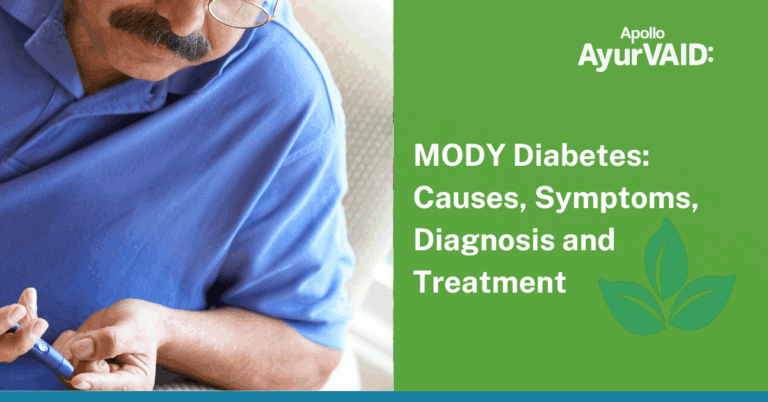Introduction
Obesity has become a global health challenge, affecting millions of people across all age groups. World Obesity Day is observed annually on March 4th to raise awareness about the global epidemic, its causes, and prevention strategies.
In Ayurveda, obesity is an imbalance in the body’s metabolism, leading to the excessive accumulation of Medo Dhatu (fat tissue). The condition is referred to as Sthoulya. It leads to loss of body strength and many other complications. Thus, early intervention is recommended for better management.
Ayurvedic weight loss methods aim to correct metabolic disturbances, normalize digestion, and encourage healthy lifestyle practices. The comprehensive Ayurvedic treatment approach for weight loss includes Panchakarma treatments, dietary changes, and even physical activity, which can deliver sustainable results. Knowing the signs, symptoms, and causes of obesity from the Ayurveda perspective will let people apply personalized obesity treatment in Ayurveda and also bring back health. This blog will have a more in-depth discussion on obesity and the Ayurveda approach towards it.

Obesity in Ayurveda
Sthoulya is caused by an imbalance in Kapha dosha, which leads to the accumulation of Meda Dathu (fat tissues). Excess accumulation of fat and muscle tissue leads to sagging around the abdomen, hips, and breasts, called Atisthoulya (individuals are categorized under Ashta Nindita purusha, one of the eight undesirable body constitutions), making the person susceptible to several diseases.
Sthoulya is not defined merely by weight or BMI but by physical signs, mainly the unequal nourishment of dhatus (excess meda and mamsa and less of other dhatus), leading to loss of body strength.
Obesity is seen as a risk factor for various other diseases, including heart-related issues.
Medoroga and Medo Vriddhi also indicate excessive fat accumulation with the depletion of other tissues, increasing the risk of severe health issues.
Signs And Symptoms of Obesity
Following are the signs and symptoms of obesity as per Ayurveda –
- Javoparodha (Reduced quickness in activity) – Meda’s properties like laxity, heaviness, softness, and delicateness cause a person to lose quickness, speed, and swiftness in physical activities.
- Gauravata (heaviness) – Heavy property of Kapha and Meda (fat), produces gauravata (heaviness) in the body.
- Kshut adhikya (excess hunger) -. Vata influences Agni (digestive fire) and leads to increased action, leading to quicker digestion of food and a longing for more food.
- Chala sphik udara stana (sagging buttocks, abdomen, and breasts) – This is caused by excessive fat accumulation in the body.
- Sveda adhikya (excess perspiration) – A Low body surface area compared to adipose mass causes obese individuals to sweat more to expel excess heat.
- Trushna adhikya (excessive thirst/polydipsia) – This is caused by aggravated Vata in Kostha (Gastro intestinal tract), stimulating the digestive fire and the body’s need to excrete excessive glucose through urine, drawing in water, and increasing urine volume.
- Saada (exhaustion) – Fat tissue blocks tissue channels, preventing proper development of Dhatus (bone, marrow, Shukra), leading to increased tiredness
- Svapna krathana (snoring) – Kapha obstructs the respiratory system, resulting in stridor.
- Durgandha (foul body odor/bromhidrosis) – This can be due to imabalanced fat, the nature of fat itself and excess sweating.
- Alpa prana (short breaths) – This indicates decreased life expectancy and hypoxia, potentially caused by hypercholesterolemia, hyperlipidemia, and atherosclerosis, leading to cardiac manifestations.
- Kshudra shwasa (gasping for air/shortness of breath/dyspnoea) – Increased respiratory movement after slight exertion. It may be caused by excess fat and a hyper-functioning heart that can lead to pulmonary congestion.
- Alpa maithuna (less sexual strength/erectile dysfunction/hypogonadism/infertility) – This is due to the depletion of Shukra dhatu (reproductive system) and obstruction of shukravaha strotas by meda, leading to difficulties with sexual life and infertility.
- Ayathopachaya (improper deposition of fat) – Improper fat deposition in the abdomen, thigh, and breast.
- Atinidra (Excess sleep) – Excess sleep is commonly observed in obesity. Aggravated Kapha obstructs the channels, causing heaviness of the body; from heaviness follows laziness, which causes excess sleep.
- Jadya (Inertia or dullness) -. Obesity results from weak digestion, causing the formation of Ama Rasa (undigested substances) and excess fat, causing heaviness and dullness.
- Moha (delusion, imprecise work) – This refers to a delusion of the mind, where the formation of Ama and increased bodily waste products affect the Doshas of the mind.
Ayurvedic Treatment for Weight Loss
Ayurvedic weight loss concepts revolve around restoring balance in the body through:
- Diet (Ahara): Favouring Kapha-reducing foods while ensuring adequate nutrition.
- Lifestyle (Vihara): Incorporating regular exercise and avoiding sedentary habits.
- Mental Well-being (Manasa): Managing stress and promoting mental wellness.
- Enhancement of the Digestive Fire (Agni): Improves digestion to prevent intoxication by Ama.
Kapha Dosha and Medodhatu Depletion Therapy would treat the body along with metabolic enhancing effects fat tissue reduced. Therapies are classified into two groups: the first is Dravya Chikitsa (medicine therapy), and the other is Adravya Chikitsa (non-medicine).
- Dravya Chikitsa: Classical Ayurveda therapies and formulations to address obesity’s root cause are administered. Ayurveda cleansing and detoxifying therapies like Vamana-emesis, Virechana-purgation, Vasti-medicated enemas, and Udwarthanam-powder massage are helpful for weight reduction.
- Adravya Chikitsa: Changes in lifestyle and practices that support weight loss. These include exercise, fasting, and avoiding daytime sleeping.
Conclusion
Obesity (Sthoulya) in Ayurveda is considered an imbalance of the doshas, mainly an increase in Kapha causing the accumulation of Meda Dhatu, rather than merely an overweight or BMI reading. The symptoms typically include dyspnea-thirst, sexual debility, and improper fat distribution, which are signs of disturbed metabolism and loss of overall health. Ayurveda treatment of Sthoulya focuses on restoring balance through a wide spectrum of factors: Ahara (food), Vihara (way of living), Manasa (state of mental well-being), and Agni (digestive fire). Thus, the treatment methods will be Dravya Chikitsa, having to do with medicine, using herbs and cleansing regimes (therapies) such as Vamana and Virechana-and Adravya Chikitsa-non-medicine treatment, which may include exercise, fasting, etc. This comprehensive approach aims to shed extra weight, correct the underlying metabolic imbalance, improve the digestive system, and make the person gain overall wellness with a personalized approach.

References
- Guled, D S, Kayachikitsa, M (2021). Sthoulya Asthadosha- Review on understanding of complications of obesity through Ayurveda and modern science. Journal of Ayurvedic and Herbal Medicine. https://doi.org/10.31254/jahm.2021.7411
- More MM, Begani NS. Sthoulya (2021): An Ayurveda Review Study. World J Pharm Med Res. 2021;7(5):93-98.
- Tiwari, N et al. (2017). AN INNOVATIVE APPROACH FOR MANAGEMENT OF OBESITY THROUGH AYURVEDA: A REVIEW. International journal of research in ayurveda and pharmacy, 8, 137-139. https://doi.org/10.7897/2277-4343.085261
- Joshi, R A et al. (2018). Role of Panchakarma and Yoga in treatment of obesity. Environment Conservation Journal. https://doi.org/10.36953/ecj.2018.19315
- Rathore, A et al. (2024). Management of Stholya (Obesity) by Panchakarma. AYUSHDHARA. https://doi.org/10.47070/ayushd
hara.v11i1.1426






